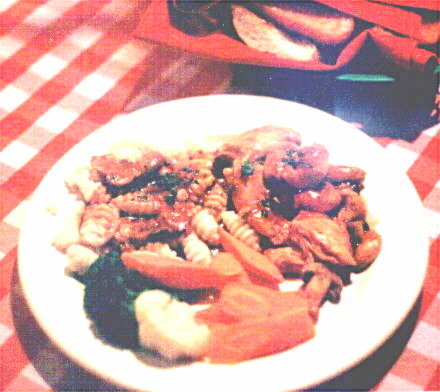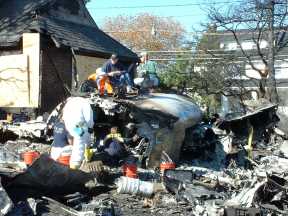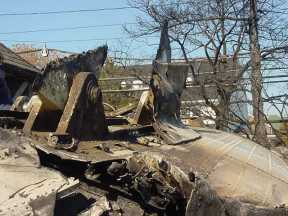The crash of American Airlines flight 587 on November 12, 2001, presented the National Transportation Safety Board with a unique challenge. This was the first airliner crash we have investigated that involved an in-flight failure of a major structural component made of composite materials - in this case, the vertical stabilizer and its attached rudder.
We knew very shortly after the crash that we needed to find a facility that had the expertise and equipment necessary to assist us with an extensive examination of these components. The American people are fortunate to have such a facility right here at NASA Langley Research Center, where they have been working on composite materials in aviation for decades.
Because of continuing public interest in the composite issue, we at the NTSB and NASA wanted to give you the opportunity to see the facility, explain what we have done so far and let you know the Safety Board's investigative plan.
After initial visual examination and documentation in a hangar in New York, the tail section pieces of flight 587, including the vertical stabilizer and rudder recovered from Jamaica Bay very soon after the accident, were brought here in early December. We've been working on it ever since.
Although there could be a number of reasons for the vertical fin to have separated from the aircraft in flight, we can boil them down to one of two major alternatives. The tail fin separated either because it was subjected to aerodynamic loads that exceeded its design limitations or because it did not perform up to its design strength. Learning which occurred is why the work we are doing here at NASA - combined with other activities elsewhere - is being accomplished.
Unlike the failure of metals, which include local fracture surface markings that indicate whether it is the result of fatigue or static overload, the analysis of damage patterns of composites is more complicated. We need to thoroughly document the damage to the component, and then perform a series of analyses that will allow us to understand the failure mechanism.
Let me describe the work that has occurred thus far.
During the first months that the wreckage was here at Langley, it underwent of series of non-destructive examinations (NDE) to define the areas of damaged and undamaged structure. Those tests were: Instrumented tap test, Lamb wave test, thermography, ultrasound mapping, and x-ray radiography.
We now have entered into the stage where we are performing more intrusive examinations. The major attachment points between the vertical stabilizer and the fuselage are six lugs on the fin, made of composite materials, that fit into six metallic fittings in the fuselage, with each lug and fitting set held together by a metal pin. All six pins remained in place in the fittings on the fuselage during the accident. Major portions of three of the lugs were found still attached to the aircraft at the wreckage site, while the other three lugs broke through the hole for the pin, leaving the larger piece of these lugs attached to the tail fin that was recovered from the water. All of these lug pieces will be sent to other facilities for CT-Scans that will permit higher resolution examination than available here.
We are continuing with a highly meticulous exercise - determining whether the stabilizer was built to its design specifications and whether the design specifications and certification standards were adequate. We have cut four small sections - called coupons - from undamaged areas of the stabilizer. These will be tested - here at NASA Langley - to generate basic information on the material used in the manufacture of the fin, to see if the material was manufactured to desired specifications. You will see the rectangular holes when you view the wreckage.
As you may know, these composites are a series of layers of carbon fiber fabric or tape, with each layer laid down in a desired orientation. In this examination, we will go layer by layer to check the number, stacking sequence and orientation of each.
We will be moving into the damaged areas of the stabilizer, examining areas where the layers have separated to determine if they were caused during the fin's departure from the aircraft or if they were pre-existing.
In short, we have many months of work ahead of us here at NASA Langley.
But that isn't the whole story. Our work will not only document the damage and the physical specifications of the composite structure, it will also involve development and validation of internal and external loads, failure analysis and subsequent structural testing. That work has been going on here, as well as in France, Germany and Washington, D.C.
Our engineers have estimated the aerodynamic loads on the tail fin. After those load estimates are verified, a finite element model analysis of the vertical stabilizer will allow us to determine the reactions at the attachment points and the resulting internal loads experienced by the tail fin structure. Airbus has provided a finite element model (FEM) of the fin. NASA engineers are evaluating that model and will provide key analysis and expertise to us as the investigation continues.
All of this is aimed at determining, first, what loads were experienced by this aircraft and, second, how this particular tail fin performed with reference to its design specifications.
In a related matter, we are reviewing all design and certification documentation to make sure Airbus met the requirements during the certification process in the 1980s, and that we understand the basis for the design specifications.
I want to describe one other area of this investigation in which NASA Langley is providing assistance. As you may know, flight 587 is believed to have twice encountered wake turbulence produced by a Boeing 747 that had taken off directly ahead of it. We have provided NASA the FDR information from the accident aircraft and the 747 that gives temperature, wind speed and direction, and acceleration data. NASA will then provide a model of the wake vortices produced by the 747. The model will help us confirm external winds and to calculate loads on the vertical fin produced by the vortices. This will assist us in determining what role wake turbulence played in the accident sequence.
In addition, we are considering the need to duplicate the flight loads experienced in the cockpit through the use of motion based simulation. We would like to study the effect of those motion-induced loads on the flight crew's ability to control the airplane. One promising method is the use of NASA's Vertical Motion Simulator at NASA Ames in California. It has a very large range of motion as compared to the typical simulator's range.
Getting back to composites, we have made arrangements to acquire exemplar components for possible work in the future. We have purchased a used A300-600 rudder that has undergone NDE at Sandia National Laboratory in New Mexico. We also may use the stabilizer and rudder that have been removed from an airliner that experienced an upset event five years ago. We have not yet determined how best to employ these exemplars, but possibilities include cutting into them for examination or testing them to failure.
In the examination bay, you will see the vertical stabilizer basically intact, with the coupons and some of the lugs removed. You will see a section of the empennage to which the stabilizer was attached. And you will see the rudder, broken in several pieces. I believe we are making good progress in determining the sequence of the break-up and separation of the rudder, although we won't have conclusive results for some time.
One word of caution. You will see and photograph damage to the tail fin and pieces of the rudder. Was all of this damage the result of the separation from the aircraft, or could some of it have been pre-existing? Could the damage have been induced during recovery? We are sorting that out, one piece at a time. Beware of those who will approach you with theories on how this accident occurred based on the photos you provide. If it were that easy, we'd have solved this a long time ago.
We are fortunate to be able to tap the expertise that is available here at NASA Langley. We expect to have work going on here throughout the length of this investigation. I don't know how long that will be, but we intend to find out what caused this tragedy, the second deadliest airline accident in U.S. history.




 (May 4, 2002) -- The National Transportation Safety Board (NTSB) is calling on NASA's Langley Research Center to analyze parts from American Airlines Flight 587, an Airbus A-300 which crashed into a NY area neighborhood on November 12, 2001 shortly after take off from Kennedy Airport.
(May 4, 2002) -- The National Transportation Safety Board (NTSB) is calling on NASA's Langley Research Center to analyze parts from American Airlines Flight 587, an Airbus A-300 which crashed into a NY area neighborhood on November 12, 2001 shortly after take off from Kennedy Airport. American Airlines Flight 587 is the second deadliest airline accident in U.S. history, killing all 260 people aboard and 5 people on the ground. The cause of the accident remains a mystery.
American Airlines Flight 587 is the second deadliest airline accident in U.S. history, killing all 260 people aboard and 5 people on the ground. The cause of the accident remains a mystery.